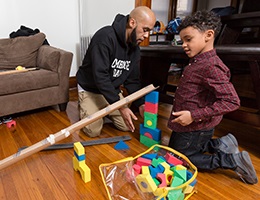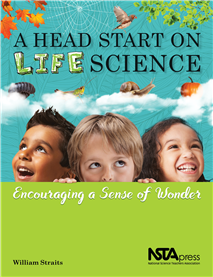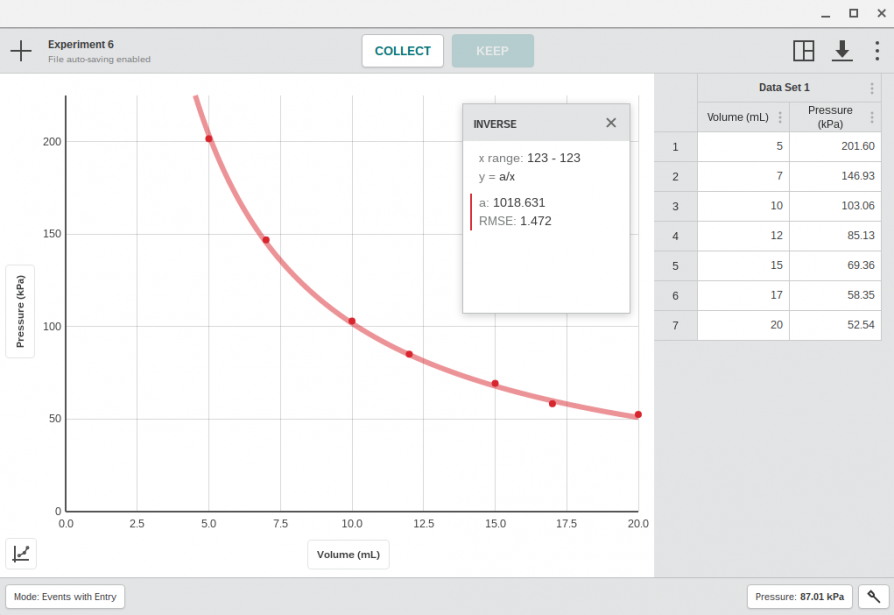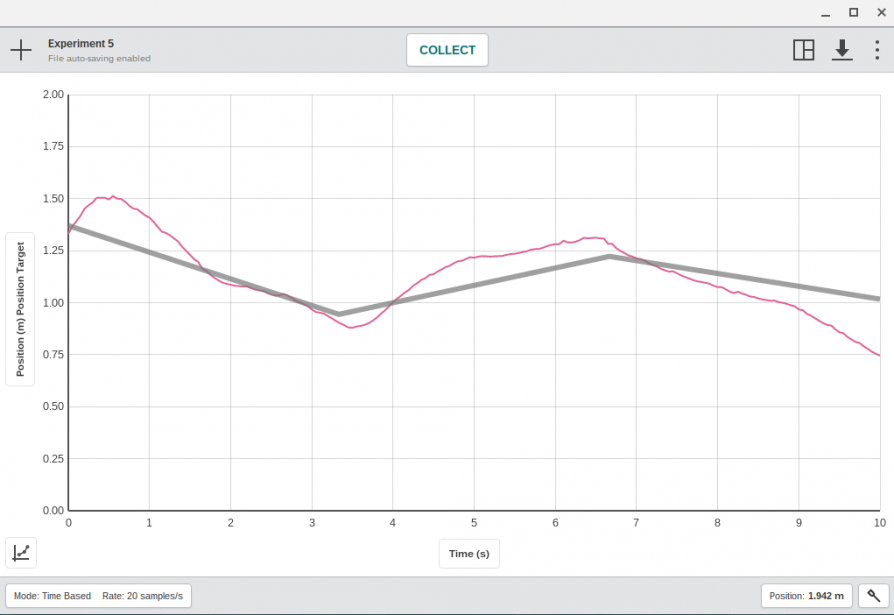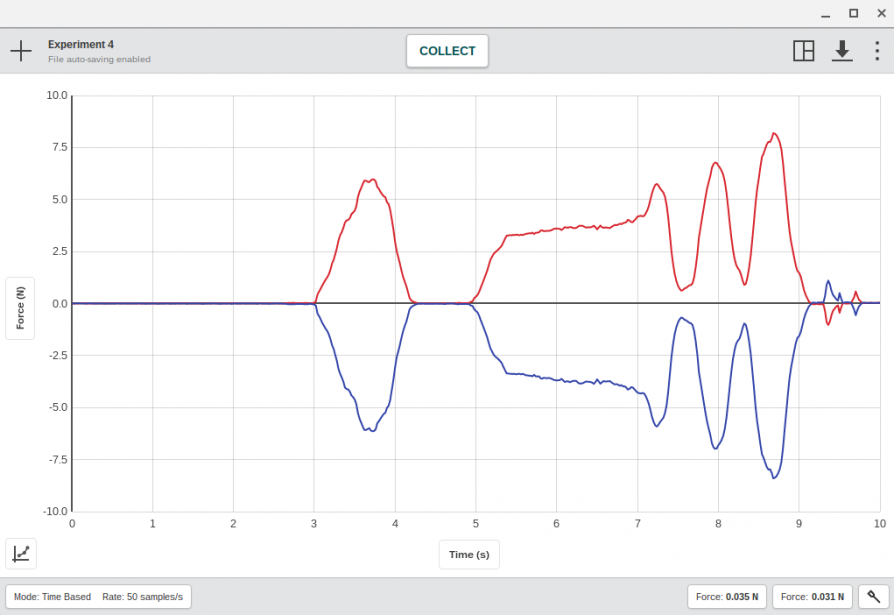
Coryn Cange, a member of the NSTA Student Chapter at Stony Brook University, guides high school students as they study water filtration in a chemistry teaching lab. Photo courtesy of Judy Nimmo
Whether they’re helping to judge a regional science fair; conducting family science, technology, engineering, and mathematics (STEM) nights; or learning about professional norms from an inservice teacher, members of NSTA Student Chapters are laying the foundations for their professional lives.
At Stony Brook University, New York, all science teacher preparation students are strongly encouraged to join NSTA and the Science Teachers Association of New York State. “This is the beginning of their professional preparation; we encourage them to become part of the larger science teacher community. We try to set [our students] off on a path that will shape their professional careers” by encouraging membership in professional organizations, explains Linda Padwa, associate director of Stony Brook’s Science Teacher Preparation Program. The students, typically either seniors or graduate students, interact with inservice teachers and secondary school students through volunteer work with the Science Olympiad and regional science fairs. They also work as assistants in the university’s Institute for STEM Education after-school program and teaching labs taught by faculty members.
“These are genuine interactions with students. [Stony Brook preservice teachers] demonstrate how to use equipment and guide [the grades 7–12] students through the lab protocols. Our students who participate in teaching labs are really ready for student teaching: They’re comfortable; they’re ready to go when they get into the classroom,” Padwa asserts. “When our students participate, they meet inservice teachers…they frequently make connections that lead to placements for student teaching and even future employment.”
She likes to remind her students of the importance of creating a professional network, telling them, “You never know where it can lead. There are no guarantees, but if you’re out there, you stand a chance.”
The NSTA Student Chapter at Central Michigan University (CMU), formed in 2002, was the seventh in the country, according to Jim McDonald, professor of science education and the chapter’s faculty advisor. The group currently runs three programs to bring more science to local schools: Family Science Nights, STEM Involvement Nights, and Science Hours.
“The students organize three family science nights a semester,” explains McDonald, who also serves as the president of the Council for Elementary Science International. The events feature six or seven activities for parents and children to do together and often include handouts if they want to continue at home. The STEM Involvement Nights are a “mix of math, science, and technology…You could call it a maker lab if you want to put that label on it.”
Only 10–15 families attend the STEM events due to the program’s more hands-on, intensive nature. CMU students give attendees a problem and a selection of recycled materials to work with as each family collaborates on a solution. “We may target different grade levels every year,” he adds. “This is not for gifted kids; it’s for kids who maybe need a shot in the arm as far as science, math, and engineering go.”
Local teachers invite CMU students to their classrooms to teach a lesson for the Science Hour programs. “Our students prepare and teach the whole lesson, and confer with the teacher to address the standards the teacher wants to address,” McDonald says. “It goes over well and is a great opportunity for our students to get some hands-on experience.”
In addition to their work with the local community, CMU students receive support from the university to attend and present at one NSTA conference a year. “The rationale is for them to present professionally and get some professional development. I want them to give back to the science education community. I want them to network with other science teachers. They’ve gotten really good feedback on their lessons, strategies, and ideas for their family science activities [when they present at conferences],” he contends.
Making Connections
Usha Rajdev, professor of math and science and the NSTA and International Association for STEM Leaders (IASL) Student Chapter Faculty Adviser at Marymount University (MU) in Arlington, Virginia, says she was concerned about “exhausting” her students if they were expected to conduct too many activities, so the NSTA and IASL student chapters work with students in the Masters in Education and Curriculum Instruction (EDCI) STEM Leaders group on four events during the academic year.
The EDCI plans the events each year, which a “core group” of NSTA and IASL student members then conduct. This year, as many as 40 students from Washington-Lee High School in Arlington assisted the MU students during individual events at area schools. Each event features multiple activities spanning life, Earth, and physical science. She describes the events as based on science, technology, engineering, art, and mathematics, but “with the emphasis in engineering and design.
“There’s some core math and technology, some show-and-tell. Sometimes parents join in. We have leaflets for them to take home and replicate,” explains Rajdev. “I’m partial to taking students to schools where the need is higher and the principal wants parental involvement.” The schools typically include a Catholic school, a school where a current student or alum is teaching, and Fort Belvoir Elementary School on the Fort Belvoir Army base.
The “finale” event is held in the MU campus gym. “It’s very similar [to the other events], except much larger. We’re not only serving the Arlington community, [we’re] also serving children of our faculty,” says Rajdev. “We have rockets; we have a professor from the arts and sciences department with a 3-D printer, a planetarium. This year, we have several community outreach programs participating, including NASA, the Arlington police department, and a nature center.” She estimates the four events reach about 1,000 children annually.
“We go to the same school for two years. The goal is the school will know how to do events and will do their own,” she declares. “We’re not only doing community service, but [also] spreading the wealth [of knowledge] we have.” The MU students “spend a lot of time over the year planning, researching, and conducting the events… This would be nothing without the students,” she maintains. The students receive certificates recognizing their community service, and the experience also helps make them more marketable in their careers, according to Rajdev.

Inservice teachers, including Catherine Sadowski (right) and Andrew Barnes (second from right), attend NSTA Student Chapter meetings at the University of Missouri, offering advice on topics such as interview clothing and professional development after graduation as part of the chapter’s effort to create a professional community. Photo courtesy of Melissa Grindstaff
When she started advising the University of Missouri (Mizzou) NSTA Student Chapter in 2016, Patricia Friedrichsen wondered—due to the chapter’s size and fluid membership —if it was possible for students to attend a chapter meeting and not interact with other members. “I started thinking about how to connect them…make them feel someone recognized they were at the meeting.”
Her solution was to invite inservice teachers to attend meetings and act as mentors to the students. “I reached out to people at different levels. It was natural to reach out to past officers… it’s a way to keep alumni connected to the club. We wanted to mentor at all levels: elementary, middle, and high school,” Friedrichsen says. During the Fall 2017 semester meetings, the mentors arrived early to discuss the meeting’s focus, and students would sit with mentors teaching their grade level or content area at each meeting. The mentoring groups created smaller communities within the chapter.
Kara Schulte, a ninth-grade physics teacher at Simonsen Ninth Grade Center in Jefferson City, Missouri, was excited about mentoring Mizzou students. “I graduated in Spring 2017 from Mizzou. The people I met in college were such a huge part of who I became [as a teacher] that I wanted to help students transition from being pure students to being a teacher,” she explains. “As a mentor, I’ve attended all chapter meetings. They talk to me about their content exams…interview questions, what to wear on an interview, what principals will ask… We basically go over things so they’re not blindsided when they go through them on their own as actual teacher…I can give very tailored advice to people who are going to be teaching the same thing I teach.”
“I’ve seen vertical mentoring with the classroom teachers mentoring undergrads. There’s also horizontal mentoring [when students discuss classes to take and assignments with peers] going on,” Friedrichsen states. “Students move through the program in cohorts. They get to know their cohort, but don’t have many other opportunities to get to know other cohorts, other years. It’s very intentional how we’re building community at the beginning of the meeting.”
She notes it was important to her to foster connections between her students and teachers in the classroom in informal settings. “To me, it’s all about connections…helping students network, get to know people outside their immediate circle.”
Another way she encourages students to expand their circle is by presenting at the Science Teachers of Missouri (STOM) conference. The Mizzou students shared apps “that highlight particular Next Generation Science Standards (NGSS) standards. They presented different tech tools to help with the implementation of NGSS.”
Friedrichsen reports that the presentation caught the attention of the STOM board, and STOM recently appointed a Mizzou student to serve as a director at- large as the group explores ways to draw more preservice teachers to the conference.
This article originally appeared in the March 2018 issue of NSTA Reports, the member newspaper of the National Science Teachers Association. Each month, NSTA members receive NSTA Reports, featuring news on science education, the association, and more. Not a member? Learn how NSTA can help you become the best science teacher you can be.
The mission of NSTA is to promote excellence and innovation in science teaching and learning for all.
Follow NSTA





